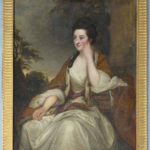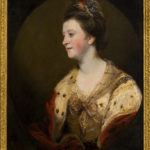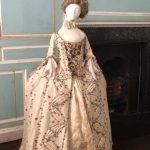SHOPPING FOR FASHION, 18TH CENTURY STYLE!
To be transported back in time to another era, to learn about the cultural, social and political attitudes of that time is what makes period dramas so popular. For me, I was especially fascinated by the peculiarities and extravagance of historical clothing. The beautiful gowns and the intricate detail adorning them, is all the more astonishing when I remembered that these dresses were hand sewn. Clothing was extremely important to the 18th century lady, such as Lady Louisa, as a reflection of their wealth and status, but did you ever wonder where such women acquired their clothes and how they kept up with current trends?
The ‘consumer revolution’ of the 18th century brought about a radical change in shopping, as the choice of products and the desire for luxury items spiralled. The buying and selling of goods moved from the market stallholder, to the shopkeeper, transforming towns and cities, including Dublin and London. New shops and the fashionable ‘warehouse’, sprang up all over Europe, along with newly widened streets, fanciful window displays and decorative street signs. Tea was provided in ante rooms as ladies engaged in polite conversation and purchases were based on a system of buy now, pay later.
Much like today, women shopped with their female companions, leaving the afternoon and evening free for entertaining. Readymade clothes were very rare in the 1700s, so women sought to buy fabric and accessories to have their gowns custom made. Textile manufactory was very much reliant on the domestic industry, so clothing would have been specially made by a local seamstress, or on occasion, a skilled ladies’ maid, employed to do both jobs. Lady Louisa, however, hired several local men and women to perform such duties, as seen in her accounts.
In the late 1789s, Lady Louisa gave Mrs Spiers 13s 4½d (approximately €55 today) to make a black gown and petticoat, presumably a mourning gown as black fabric was expensive and few women would otherwise wear black. Mrs Mans received £1 13s 5d (€142) to make up 2 riding habits for Harriette Staples and the mantua maker employed, also for Harriette, was paid £3 17s 1d (€330) for her services.
Fabric was very expensive, so clothing was either mended or altered to give the garment a longer life, this was also done by local specialists. Mr Begley, a tailor, was regularly paid to make servants clothing, but also for alterations and mending.
In 1789, he was paid 3s 3d (€13) for mending Harriette’s riding habit and 13s 5½d (€55) for altering a capote (a long coat with a hood).
As Paris was the fashion capital of Europe, all French goods were in vogue, especially silk and for the very elite members of society, nothing else would do. Dublin, at this time, was the 6th largest city in Europe and Irish men and women flocked to the newly widened Parliament Street, Westmoreland Street, D’Olier Street, Dame Street and Lower Sackville Street in search of the latest French fashions. Irish silk merchants copied the designs, but authentic French stock was only sold in the most exclusive establishments. As the century progressed, pressure mounted on the government by the Dublin silk weavers to stem the flow of French silk into Ireland, resulting in heavy duties placed on all imported French goods. This led to an alternative approach of obtaining French silk – smuggling. Smuggling was widespread in the 18th century and common among even the wealthiest of families, including the Lennox sisters. In a letter dated 1759, Lady Louisa complained to her sister Emily,
“I can’t get my French silk out of the customs House at Park Gate. They took them because they said they were French silks; the reason for that is because, unluckily, French white was wrote on them and the stupid animals refused a handsome tip.”
And in 1764, Lady Caroline Fox noted that the custom house officials in Dublin,
“are most immensely strict just now on account of the infinite quantity of French goods imported, I suppose it is a bad time to attempt getting anything from abroad.”
The influx of French silk coming into the country continued to damage the livelihoods of the Irish weaver and in 1764, the Dublin Society established a silk warehouse on Parliament Street, which offered a 3 per cent premium on all Irish silks. Those who spent over £100 (approximately €8,500 in today’s money) on silk per year, were entitled to become patrons. Both Louisa and Emily Lennox were among the first patrons, this would have meant regular visits to the warehouse and an input into the designs of the fabric.
Toward the end of the 1700s, linen, muslin and cotton replaced silk as the favoured choice of material for dressmaking and Lady Louisa continued to support the Irish economy, purchasing most of her fabric from local drapers and Dublin warehouses.
Between 1786 and 1790, she paid Mr McCormack 2s (€9) a yard for printed linen, Mr Thompson £1 (€90) for a yard and half for muslin, Mr John Fawcett £2 17s 5d (€240) for 53 yards of flannel, Mr Nicholson £2 17s 8d (€245) for 32 yards of diaper (type of silk) and 9 yards of linen. She also bought flax, paying £2 1s 4 (€175) for 62lbs in 1788 and paying Mr Hayes £1 12s 6d (€137) for weaving 65lbs of linen.
Furthermore, Lady Louisa’s accounts indicate the importance of accessories and trimmings to the fashion conscious, especially headwear, for bringing an outfit in line with current trends.
In 1786, she paid the hefty sum of £12 10s 3d (€1050) to Mrs Crowe for trimmings and 19s 11½d (€85, nearly a week’s wage for a tradesman at the time) for lace from a Longford pedlar.
The aforementioned Mrs Eliza Crowe and Mrs A. Morlet, a milliner used by Lady Louisa, were not only favoured by Lady Louisa, but by other wealthy ladies such as the Duchess of Rutland. Lady Louisa employed many milliners including, Mrs Spring of Leixlip, Mrs Guidou, Mrs Kearns and Mrs Hamilton demonstrating the necessity of the hat as a way of breathing new life into an older outfit.
It has to be said, however, not all of Lady Louisa’s purchases were made by herself, shopping on behalf of friend or family member was common, especially when the designated shopper was going abroad. On an occasion to be in Paris, Lady Caroline Fox writes to her family.
“I must tell you that the winter silks are beautiful beyond imagination, to my taste at least, especially those velvet ones without gold or silver, under £30 English. One may have a gown as rich as it’s possible to be without gold or silver, there are satins with chenille flowers in two colours, and several colours very pretty. They are dear in proportion, a gown of one of them comes to almost £14 or £15. I tell you all this in case you should have any commands.”
Some may be surprised to know; men were often the first choice as ‘proxy shoppers’. Men were more inclined to travel and so became experienced buyers. In many cases, their knowledge of the quality and cost of fabrics were second to none.
In 1788, Lady Louisa reimbursed Mr John Castles for a pair of clogs he brought back from England. Castles may have been a servant; it was not uncommon for servants to make purchases for their employer. The Duke of Richmond’s account was reimbursed to cover the costs of a glover by the name of Mr Cahill and in 1787 she gave the Duke of Leinster money for 5 yards of muslin.
But without the use of technology such as photography, telecommunications or high speed transportation, how did women know what was what in the world of fashion? Letter writing was a great way for women to exchange new ideas and this correspondence has become a great source of information for fashion historians such as Amber Butchart and Hillary Davidson. Unfortunately, the written word is not always enough as Lady Sarah Lennox discovers. When writing to her sister, Lady Emily Lennox, about how to wear a new type of handkerchief, called the Henri IV, you can almost hear her frustration.
“Do you know that I am as dull as a post about dress? For in the first place, I don’t know how to put on the handkerchief, though I see it is all haffly and pretty. Secondly, I don’t comprehend you about the gauze round my head. Why, I shall look as if I had a sore head, if it’s white gauze! Or is it to be black? But pray, in an undressed cap what is the shape one’s head ought to be? Is the outline like a sugar-loaf tumbling off and all flat and low before, or is there any pretensions to following the natural shape of one’s head? I wish Charlotte would draw me some outlines of heads, some to see and some to imitate.”
In France, fashion designers used dolls to display their new designs but there is no evidence of dolls in Ireland at this time. By the 1780s descriptions in magazines and periodicals began to appear in papers such as, the Dublin Evening Post, the Evening Herald and Walkers Hibernian. These descriptions were copied nearly word for word from French magazines and could be interpreted to suit an individual and made using locally produced fabrics. From the late 18th century fashion plates showed ladies and their dressmakers what fashionable society was wearing in London and Paris. Styles had begun to change rapidly, and fashion plates were increasingly relied upon to suggest the latest and most appropriate outfits for different times of the day and for specific occasions. A number of periodicals aimed at women, such as the Lady’s Magazine (1770-1832) followed with more frequent and regular plates to show what society was wearing. Early plates were issued uncoloured, though may have been coloured by dressmakers to inspire their clients. A favourite dress that was no longer wearable could then be taken apart and used as a pattern. By 1790, those in the Lady’s Magazine were ’embellished’ with hand-colouring, and the practice of including regular coloured plates had begun. As Lady Louisa subscribed to the Lady’s magazine, paying Mrs Woodward £5 13s 9d (€475) subscription fee, perhaps she too made use of these patterns.
Of course, the internet has transformed the way we shop today, but for some of us, the habits forged in the 1700s continue today. There are few activities enjoyed more than a catch up with old friends over coffee, before indulging in a little retail therapy or scanning style magazines in search of inspiration and exchanging fashion tips, much like the Lennox sisters. Sadly, with the industrial revolution came the mass production of clothing and the skill of the 18th century dressmaker has become a dying art.
The Berkeley Collection, housed at Castletown House, is a wonderful collection of original 18th and early 19th century clothing and are great examples of the ability and expertise that went into dressmaking at this time.
Thanks to Castletown Guide Kate for this insight into the history of shopping.



